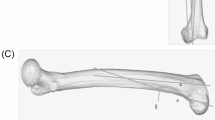Abstract
Background
To study the accuracy of using the deepest point of the intercondylar notch (DPIN) as a reference point for femoral intramedullary (IM) guiding rod entrance in total knee arthroplasty (TKA) with 3-D reconstruction in Chinese subjects.
Methods
A total of 50 normal femurs in 25 Chinese subjects (mean age 25.6 ± 2.9 years; range 18–29 years) were chosen from the lower extremities computed tomography digital imaging and communications in medicine (DICOM) database for this study. The DICOM data were imported into Mimics 10.0 software. A cylinder (radius = 4 mm; length = 20 cm) was used to simulate ideal insertion of a IM guiding rod into the femoral canal. DPIN was taken as a reference point for calculating the relative position of the rod’s entry point.
Results
The mean rod entry point position in the coronal plane was 2.94 ± 1.12 mm (range 0.79–4.91 mm) medial and 6.01 ± 2.09 mm (range 2.49–9.51 mm) anterior to the DPIN, with no significant difference between sides. All potential angle errors were below 2°.
Conclusion
The results of this study show that the DPIN can serve as a reference for surgeons using an IM guide system in TKA.




Similar content being viewed by others
References
Nouta KA, Pijls BG, Nelissen RGHH (2012) All-polyethylene tibial components in TKA in rheumatoid arthritis: a 25-year follow-up study. Int Orthop 36:565
Zhang HY, Blunt L, Jiang XQ et al (2011) The significance of the micropores at the stem-cement interface in total hip replacement. J Biomater Sci Polym Ed 22:845
O’Connor MI (2011) Implant survival, knee function, and pain relief after TKA: are there differences between men and women? Clin Orthop Relat Res 469:1846
Lombardi AV Jr, Berend KR et al (2011) Neutral mechanical alignment: a requirement for successful TKA: affirms. Orthopedics 34:691
Zhang HY, Brown L, Blunt L et al (2011) The contribution of the micropores in bone cement surface to generation of femoral stem wear in total hip replacement. J Biomater Sci Polym Ed 44:1476
Nuno-Siebrecht N, Tanzer M, Bobyn JD (2000) Potential errors in axial alignment using intramedullary instrumentation for total knee arthroplasty. J Arthroplasty 15:228
Jeffery JA (1999) Accuracy of intramedullary femoral alignment in total knee replacement: intraoperative assessment of alignment rod position. Knee 6:211
Reed SC, Gollish J (1997) The accuracy of femoral intramedullary guides in total knee arthroplasty. J Arthroplasty 12:677
Novotny J, Gonzalez MH, Amirouche FM et al (2001) Geometric analysis of potential error in using femoral intramedullary guides in total knee arthroplasty. J Arthroplasty 16:641
Kim JG, Kasat NS, Bae JH et al (2012) The radiological parameters correlated with the alignment of the femoral component after Oxford phase 3 unicompartmental knee replacement. J Bone Jt Surg Br 94:1499
Johnson DR, Dennis DA, Kindsfater KA et al (2013) Evaluation of total knee arthroplasty performed with and without computer navigation: a bilateral total knee arthroplasty study. J Arthroplasty 28:455–458
Ma B, Long W, Rudan JF et al (2006) Three-dimensional analysis of alignment error in using femoral intramedullary guides in unicompartmental knee arthroplasty. J Arthroplasty 21:271
Arima J, Whiteside LA, McCarthy DS et al (1995) Femoral rotational alignment, based on the anteroposterior axis, in total knee arthroplasty in a valgus knee: a technical note. J Bone Jt Surg Am 77:1331
Bland JM, Altman DG (1986) Statistical methods for assessing agreement between two methods of clinical measurement. Lancet 1:307
Laskin RS (1984) Alignment of total knee components. Orthopedics 7:62
Laskin RS (1986) RMC total knee replacement: a review of 166 cases. J Arthroplasty 1:11
Meding JB, Berend ME, Ritter MA et al (2011) Intramedullary vs extramedullary femoral alignment guides: a 15-year follow-up of survivorship. J Arthroplasty 26:591
Jung W, Chun C, Lee J et al (2013) The accuracy of the extramedullary and intramedullary femoral alignment system in total knee arthroplasty for varus osteoarthritic knee. Knee Surg Sports Traumatol Arthrosc 21:629
Ng VY, DeClaire JH, Berend KR et al (2012) Improved accuracy of alignment with patient-specific positioning guides compared with manual instrumentation in TKA. Clin Orthop Relat Res 470:99
Jiang CC, Insall JN (1989) Effect of rotation on the axial alignment of the femur: pitfalls in the use of femoral intramedullary guides in total knee arthroplasty. Clin Orthop Relat Res 248:50
Tang WM, Chiu KY, Kwan MF et al (2005) Sagittal bowing of the distal femur in Chinese patients who require total knee arthroplasty. J Orthop Res 23:41
Wangroongsub Y, Cherdtaweesup S (2009) Proper entry point for femoral intramedullary guide in total knee arthroplasty. J Med Assoc Thai 92:S1
Insall JN, Easley ME (2001) Surgical techniques and instrumentation in total knee arthroplasty. In: Insall JN, Scott WN (eds) Surgery of the Knee, 3rd edn. Churchill Livingston, Philadelphia, p 1578
Oswald MH, Jakob RP, Schneider E et al (1993) Radiological analysis of normal axial alignment of femur and tibia in view of total knee arthroplasty. J Arthroplasty 8:419
Aslam N, Lo S, Nagarajah K, Pasapula C, Akmal M (2004) Reliability of preoperative templating in total knee arthroplasty. Acta Orthop Belg 70:560–564
Acknowledgments
This work was supported by Norman Bethune Program of Jilin University (2012216) and Science and Technology Development Program of Jilin Province (Grant No. 20100750). We acknowledge Joseph Lipman of the Department of Biomechanics at the Hospital for Special Surgery in New York, NY, USA for his suggestions on this manuscript.
Conflict of interest
We declare that we have no conflict of interest.
Author information
Authors and Affiliations
Corresponding author
Rights and permissions
About this article
Cite this article
Xiao, J., Wang, C., Zhu, L. et al. Improved method for planning intramedullary guiding rod entry point in total knee arthroplasty. Arch Orthop Trauma Surg 134, 693–698 (2014). https://doi.org/10.1007/s00402-014-1943-6
Received:
Published:
Issue Date:
DOI: https://doi.org/10.1007/s00402-014-1943-6




